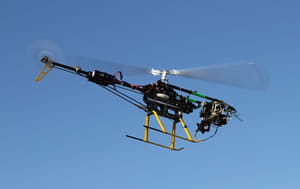About
30 April 2012
Portable Gas Sensors Improve Atmospheric Pollution Measurements
FOR IMMEDIATE RELEASE
Contact:
Lyndsay Meyer
The Optical Society
+1.202.416.1435
lmeyer@osa.org
Portable Gas Sensors Improve Atmospheric Pollution Measurements

Remote-controlled robotic helicopter in flight with a laser-based greenhouse gas sensor extending from its nose. The aerial detector is easy to deploy, inexpensive to operate, can be guided by GPS, and provides measurements in both vertical and horizontal directions.
Credit: Department of Civil and Environmental Engineering, Princeton University
WASHINGTON, April 30--Different types of compact, low-power portable sensors under development by three independent research groups may soon yield unprecedented capabilities to monitor ozone, greenhouse gases, and air pollutants. The three teams will each present their work at the Conference on Lasers and Electro-Optics (CLEO: 2012), to be held May 6-11, in San Jose, Calif.
Princeton University engineer Amir Khan and colleagues, working with space scientists at the University of Texas at Dallas, will discuss how their teams combined a compact, low-power, open-path (exposed directly to the environment) laser sensor with a robotic helicopter to measure the three most important greenhouse gases – carbon dioxide, methane and water vapor – in the atmosphere. The biggest advantage of the combination is that it provides high-resolution mapping in both the vertical and horizontal directions near emissions sources – something that ground-based networks or satellite-based sensors cannot do. Additionally, the sensor on the robotic helicopter is easy to deploy, inexpensive to operate, can be programmed to fly a preset monitoring pattern using GPS coordinates, and can handle challenging situations such as measuring emissions from industrial plants where the plumes move sideways as well as up.
A first-time demonstration of a system with the potential to become a portable, low-power, low-cost, and long-lasting optical sensor for ozone (O3) measurements will be presented by a team of engineers from the University of Rostock in Germany and Sensor Electronic Technology Inc. in South Carolina. The sensor uses light-emitting diodes (LEDs) to produce light in the deep ultraviolet range of the spectrum (wavelengths less than 300 nanometers) that allows the detection of small amounts of ozone – trace concentrations ranging anywhere from approximately 10 parts per billion to approximately 100 parts per million. The team showed in tests that this sensitivity compares favorably to conventional sensors that use less durable and more expensive mercury or electrochemical light sources. The team also discovered that coupling the deep ultraviolet LED to the detection equipment with fiber-optic cables produced a sturdy sensor that could be used in harsh environments, such as areas with strong electromagnetic fields, high temperatures, or strong vibrations.
Finally, engineer David Miller, also from Princeton University, will discuss his team’s use of an open-path quantum cascade laser to create a portable sensor that can detect extremely small quantities of atmospheric ammonia (NH3) in harsh field environments. This molecule commonly forms unhealthy particulate matter, but measurements of this pollutant in the atmosphere are lacking. The Princeton sensor has performed well when deployed in harsh environments – everything from dusty deserts to jungle-like conditions to sub-freezing temperatures – providing an ability to measure concentrations of NH3 as small as 200 parts per trillion. Data from the high-sensitivity ammonia sensor will significantly improve air quality forecasts.
CLEO: 2012 presentation JTh1L.6 “Open-Path Greenhouse Gas Sensor for UAV Applications,” by M. Amir Khan et al. is at 9:30 a.m. on Thursday, May 10 in the San Jose Convention Center.
CLEO: 2012 presentation JTh1L.1“Deep Ultraviolet LED-Based Ozone Sensor,” by Yuri Bilenko et al. is at 8 a.m. on Thursday, May 10 in the San Jose Convention Center.
CLEO: 2012 presentation ATh3L.7 “Assessing Field Performance of an Open-Path Quantum Cascade Laser Sensor for Measuring Atmospheric Ammonia,” by David J. Miller et al. is at 3:45 p.m. on Thursday, May 10 in the San Jose Convention Center.
EDITOR’S NOTE: A high-resolution image of the robotic helicopter is available to members of the media upon request. Contact Lyndsay Meyer, lmeyer@osa.org.
Press Registration
A Press Room for credentialed press and analysts will be located on-site in the San Jose Convention Center, May 6 – May 11. Media interested in attending the conference should register on the CLEO website or contact Lyndsay Meyer at 202.416.1435, lmeyer@osa.org.
About CLEO
With a distinguished history as the industry's leading event on laser science, the Conference on Lasers and Electro-Optics (CLEO) is where laser technology was first introduced. CLEO unites the field of lasers and electro-optics by bringing together all aspects of laser technology, with content stemming from basic research to industry application. CLEO: Expo showcases the latest products and applications from more than 300 participating companies from around the world, providing hands-on demonstrations of the latest market innovations and applications. The Expo also offers valuable on-floor programming, including Market Focus and the Technology Transfer program.
Sponsored by the American Physical Society's (APS) Laser Science Division, the Institute of Electronic Engineers (IEEE) Photonics Society and the Optical Society (OSA), CLEO provides the full range of critical developments in the field, showcasing the most significant milestones from laboratory to marketplace. With an unparalleled breadth and depth of coverage, CLEO connects all of the critical vertical markets in lasers and electro-optics. For more information, visit the conference's website at www.cleoconference.org.
###
